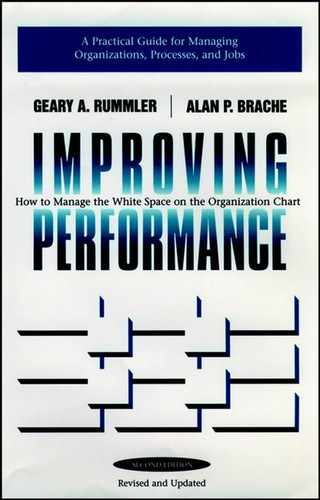3.6. Process Level
When we lift the lid and peer inside an organization, the first things we see are the various functions. However, the systems view suggests that this perspective does not enable us to understand the way work actually gets done, which is a necessary precursor to performance improvement. For this understanding, we need to look at processes. Most key dimensions of organization performance result from cross-functional processes, such as order handling, billing, procurement, product development, customer service, and sales forecasting. Chapter Five more fully explores the Process Level; the following is an overview of its three Variables, using Computec as an example.
Process Goals. Since processes are the vehicle through which work gets produced, we need to set goals for processes. The goals for processes that touch the external customer (for example, sales, service, and billing) should be derived from the Organization Goals and other customer requirements. The goals for internal processes (for example, planning, budgeting, and recruiting) should be driven by the needs of the internal customers. (In Chapters Five and Eleven, we discuss process-oriented goal setting in more depth.)
Functional goals, which are part of the Organization Management variable just discussed, should not be finalized until we see the contribution that each function needs to make to the key processes. Each function exists to serve the needs of one or more internal or external customers. If a function serves external customers, it should be measured on the degree to which its products and services meet those customers' needs. If a function serves only internal customers, it should be measured on the way it meets those customers' needs and on the value it ultimately adds to the external customer: In both cases, the key links to the customer are the processes to which the function contributes.
The installation process, for example, is critical to any company that installs equipment in a business or a residence. One function that contributes to the installation process is the sales department. Even though sales may not be part of the installation itself, it is part of the installation process because salespeople usually write orders that include specifications for equipment installations. Because it has a significant impact on the quality and timeliness of an installation, the sales department should be measured on the accuracy, specificity, understandability, and timeliness with which its people provide installation specifications to the department that performs the installation. Installation specification goals are not necessarily part of the sales measurement system. However, when you look at the organization as a set of processes, and at the sales department in terms of the contributions it makes to all the processes it supports, a richer set of goals emerges.
For our overview of Computec's performance in terms of Process Goals, we have two primary questions: Does the company have goals for its processes (particularly those cross-functional processes that influence the strategy)? Are the Process Goals linked to customers' requirements and to the Organization Goals?
Given Cornputec's strategic thrusts and vulnerabilities, its key processes are the product/service development process, the customer support process, and the order-filling process (for its off-the-shelf software). Not surprisingly, Computec has no goals for these processes. Furthermore, its functional goals do not support the optimal performance of these processes.
Process Design. Once we have Process Goals, we need to make sure that our processes are structured (designed) to meet the goals efficiently. Processes should be logical, streamlined paths to the achievement of the goals. As part of our Computec analysis, we have one simple question that addresses this variable: Do the company's key processes consist of steps that enable it to meet Process Goals efficiently?
Earlier, we determined that Computec has no Process Goals. However, we can still examine its three key processes. The mechanism for product development and introduction is not really a process, by anyone's definition of the term. Products and services eventually emerge from poorly coordinated projects, which are characterized by functional bickering, budget overruns, missed deadlines, and lack of ownership. When the order-filling process is analyzed, the only surprise is that Computec does occasionally meet customers' expectations for quality and timeliness. A customer support process has never really been created. This company has a lot of work to do in the process area. (Examples of Computec processes appear in Chapter Five.)
Process Management. A process with a logical structure will be ineffective if it is not managed. Process Management includes the same ingredients as Organization Management:
Goal Management: Involves establishing subgoals at each critical process step. These goals should drive functional goals.
Performance Management: This involves regularly obtaining customer feedback on the process outputs, tracking process performance along the dimensions established in the goals, feeding back performance information, identifying and correcting process deficiencies, and resetting process goals to reflect the current customer requirements and internal constraints.
Resource Management: Involves supporting each process step with the equipment, staff, and budget it needs to achieve its goals and make its expected contribution to the overall Process Goals.
Interface Management: Involves managing the "white space" between process steps, especially those that pass between functions. As at the Organization Level, where the greatest opportunities for improvement lie between functions, the greatest process improvement opportunities often lie between process steps.
Does Computec manage the goals, performance, resources, and interfaces of its key processes? Since Computec has not established a cross-functional orientation to its business, it has not established a Process Management infrastructure for its key processes. (Since Process Management is so critical to performance improvement and has so many nuances, Chapter Ten is entirely devoted to that subject.)
